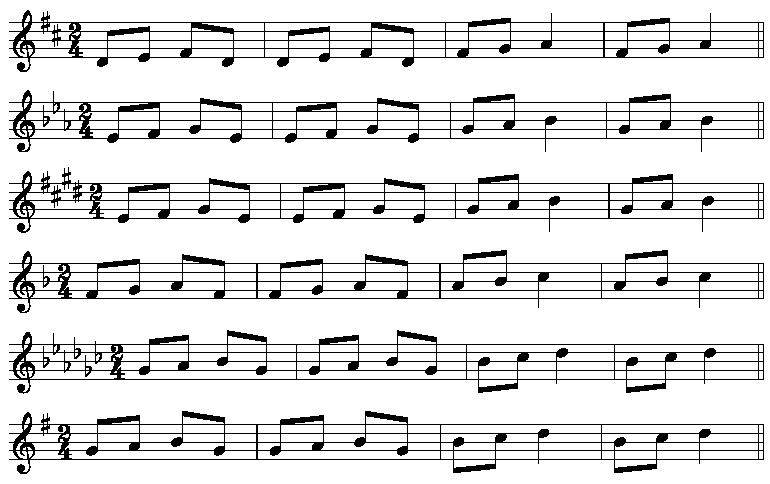| SIGHTREADING for the SERIOUS
by Robert C. Rietzke
|
Robert C. Rietzke

Instrumental music teacher
RetiredRobert C. Rietzke
holds a bachelor of arts and a master of arts degree from The College of New Jersey. He began teaching instrumental music for the Westfield (New Jersey, USA) Board of Education in 1967. During his 32+ years in Westfield he taught all the traditional band and orchestra instruments as well as conducted concert bands, orchestras, jazz bands, string, brass and woodwind ensembles in grades 4 - 9.
|
The greatest musical difficulties encountered
by elementary and intermediate school instrumental music students are reading
rhythms and key signatures. This book gives students the opportunity to develop
the ability to read a variety of standard rhythms in any key. It may be used
effectively with students from elementary through high school level.
The self-sufficiency of young players is the
primary goal of this work. Students who have mastered the concepts addressed in
this book have no fear of key signatures or complex rhythms. They have a fuller
understanding of their instrument and how the music relates to it. Their senses
of time and of tonality are more developed, so that when confronted by new
music, they have a system that can be used to learn it.
The material consists of familiar folk tunes
and popular melodies, most of which are easily recognizable to both student and
teacher. On each page, the same melody is transposed chromatically through all
twelve major keys. The criteria for melodies are that they are contained within
the octave and have no accidentals. In this way, it can more rapidly develop the
student's ear. This also helps to reinforce the connection between the major
scales (which are found at the beginning) and the melodies. It is my feeling
that if the student develops a strong sensitivity to the major sound,
recognizing pieces written in other modes will be easier.
Eighth notes are the primary counting unit. The
pieces are arranged by rhythmic complexity. Neither diacritical/articulation
markings nor tempo indications are present, so as to present the fewest
obstructions to the development of rhythm and ear.
Often, students learn all the major scales and
are able to perform them very fluently but cannot apply the tonal principles to
reading melodies. More advanced students who have displayed a high skill in
playing all the major scales, when asked to play even the simplest melodies
through all twelve keys, are not immediately successful. Once students
understand the connection between theoretical concepts such as scales and
rhythms, they are able to sightread music more quickly, allowing for more time
to be dedicated to more musical concepts of expression.
Playing through the keys helps to train the ear
because the rhythm remains the same while the pitches change. Once the rhythm is
mastered, the students can listen to hear that the melody is correctly recreated
in the new key.
Foot-Tapping
Although it is essential, there is often too
much emphasis on pitch during early development. In subsequent years, the most
frequently encountered problems are not related to pitch-reading or fingering,
but are rhythmic. Consistent use of proper foot-tapping techniques is essential
for both rhythmic and melodic development. I have observed that students who use
proper foot-tapping techniques tend to stop tapping when unsure of a rhythm or a
pitch. Students who are made aware of this tendency can actually make better use
of their practice time because the problem area is clearly marked when the foot
stops tapping. Students who do not use proper foot-tapping techniques are rarely
aware they are playing a rhythm incorrectly and have no way of knowing if a
mistake has been made. "Wasn't that perfect?" is a common phrase used by these
students. They have no guide for determining what is rhythmically right or
wrong.
How To Use The Book
This book may be used as a warm up for
ensembles and also in individual or group lessons. It presents sightreading
material designed to solidify the sense of tonality in all major keys. While
intended for use by those instructors who wish to teach all twelve major scales,
it can also supplement standard methods, addressing any key as needed. Once a
scale is learned, students are capable of playing any of the melodies in that
key. No additional notes are used. Instructors who wish to practice sightreading
in a particular key can use this book for preparatory material in conjunction
with their ensemble music.
This is a sample of the first six lines of page one.

>email to: bob@rietzke.net
>SAMPLE
<

